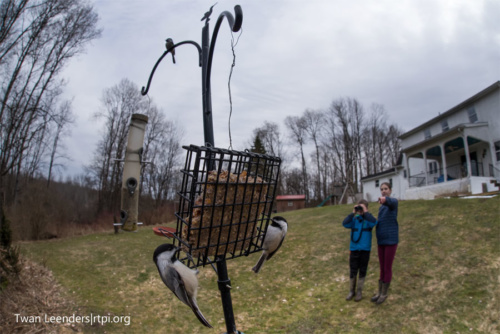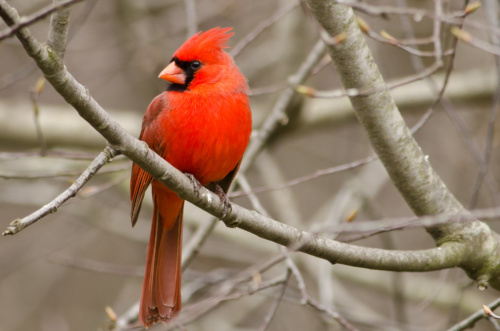Over President’s Day weekend (Friday, February 14 thru Monday, February 17, 2020), bird
enthusiasts of all ages and abilities throughout the world are urged to count birds in their
backyards or local parks as part of the annual Great Backyard Bird Count. It doesn’t cost money.
You can do it “bare-handed” just by watching out your kitchen window. It’s fun and educational.
And it really helps contribute valuable information to bird conservation.
The Falconer Public Library will host a free indoor introduction to the Great Backyard Bird
Count on Wednesday, 02/12 from 5:30 – 6:00 PM. Craig Thompson, Vice Chair of the Audubon
Council of New York State, will discuss how bird enthusiasts can conduct a simple 15-minute
Bird Count while watching their bird feeders during the 4-day weekend. Those interested in
participating a free field practicum can join Mr. Thompson at Falconer Park on Saturday, 02/15
from 10 – 11 AM. Participants are asked to dress for the weather and ground conditions.
Binoculars helpful but not necessary. Those interested in attending either session are asked to
register with Mr. Thompson at 518-788-7412 by c.o.b Tuesday, 02/11.

Dark-eyed Junco (Junco hyemalis) . Photo credit: Twan Leenders.
To be honest, around here mid-February is an absolutely lousy time to ask people to count birds.
The weather is often intolerable, for people and for birds.
The winter snow is as deep as it gets.
You’ve got a bad case of the winter “blahs”.
Even the ground-hog went back to sleep!
And the only birds out there are the “usual suspects”: our hearty year ‘round species, plus several
common winter visitors, and maybe a few unexpected transient birds forced down from Canada
for lack of food.
But this is precisely why counting birds during the Great Backyard Bird Count is of value to
ornithologists. By now, birds have completed their migratory itineraries and are “where they
should be”, in contrast to the National Audubon Society’s Christmas Bird Count, which often
counts birds while they are still in transition. The Great Backyard Bird Count shows where the
birds are in the dead of winter. And the neat thing is, when everyone counts birds on the same
weekend, you’ve got an instant crowd-sourced database which provides researchers a robust
snapshot of bird distribution and abundance.

Sponsored by the National Audubon Society, Cornell’s Laboratory of Ornithology and Bird
Studies Canada, the Great Backyard Bird Count is now in its 23rd year, a rich longitudinal
survey useful for tracking changes in winter bird ranges. Carolina wren, for example. Birds are
excellent environmental monitors, and studying fluctuations in bird abundance and/or
distribution over time can reveal trends. Which then begs the question “why the trend?”,
ultimately helping to inform sound conservation strategies. In the Carolina wren’s case, many
attribute an apparent recent expansion of its winter range into upstate New York to climate
change.
So, how can you contribute to the Great Backyard Bird Count bird survey? Merely choose a time
and location for your survey on one or more of the operative dates. When you “go live”, simply
keep track of the highest number of individuals of each bird species that you can see in your
“field of view” at any one time during your count period, like if you took a picture. Keep taking
those “pictures” and recording “highest count” data for each species for at least 15 minutes, or
more if you like. Some familiarity with common winter bird species is necessary*, so keep a bird
guide handy for those “gotcha” moments. Once you are done “counting”, log on to
www.birdcount.org and follow the links to establish your (free) Great Backyard Bird Count
account, identify your locale and then log in your data. There’s other cool stuff on that URL to
peruse, too. It’s very easy to collect and to report your field data and it is, of course, of the utmost
importance to bird conservation that you actually take time to log your data in.

Northern Cardinal (Cardinalis cardinalis)
The Great Backyard Bird Count is a great opportunity to get to know your local birds better and
to be involved in bona fide citizen science at the same time. Other bird-related citizen-science
initiatives in which you might be interested include the National Audubon Society’s Christmas
Bird Count, NYS DEC’s Breeding Bird Atlas, and Cornell’s Project FeederWatch and its e-Bird
database. No other scientific discipline has relied so heavily as ornithology on raw data gathered
from everyday people. Thanks to these and other citizen science programs, the active
engagement of rank amateurs has been critical to the advancement of conservation science.
But just a word of warning: bird watching can be habit forming.
* Top 10 bird species reported in the eastern US during the Great Backyard Bird Count:
Northern Cardinal; Mourning Dove; Dark-eyed Junco; American Goldfinch;
Downy Woodpecker; Blue Jay; House Finch; Tufted Titmouse; American Crow; Black-capped
Chickadee












